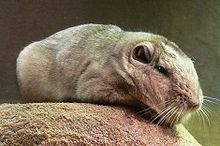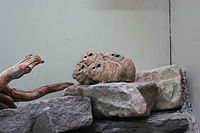- Gundi
-
This article is about the rodent. For the village in India, see Gundi, Bihar.
Gundi
Temporal range: Early Oligocene–Recent
Ctenodactylus gundi Scientific classification 
Kingdom: Animalia Phylum: Chordata Class: Mammalia Order: Rodentia Suborder: Hystricomorpha Family: Ctenodactylidae
Gervais, 1853Genera Ctenodactylus
Felovia
Massoutiera
PectinatorGundis (family Ctenodactylidae) are a group of small, stocky rodents found in Africa. They live in rocky deserts across the northern parts of the continent. The family comprises 4 living genera and 5 species (Speke's Gundi, Felou Gundi, Desert Gundi, North African Gundi and Mzab Gundi), as well as numerous extinct genera and species (McKenna and Bell, 1997). They are in the superfamily Ctenodactyloidea. They first came to the notice of western naturalists in Tripoli in 1774 and were given the name 'gundi mice'.[1]
Characteristics
Gundis are from 17–18 cm in body length, with compact bodies covered in soft fur, short legs, and large eyes. Gundis have short tails, which in some species are covered in a large fan of hair that aids in balancing as they move about their rocky and uneven environment. They are herbivorous, eating almost every type of available plant. Like many other desert animals, they do not drink, obtaining all the moisture they need from their food.[2] Their incisors lack the layer of tough, orange, enamel found in other rodents, and they have a dental formula of:
Dentition 1.0.1-2.3 1.0.1-2.3 Females typically give birth to two young at a time, after a gestation period of about two months. Because of the need to preserve moisture, female gundis produce only a small amount of milk, and the young are fully weaned by four weeks of age.[2]
Gundis live in colonies of up to a hundred or more individuals, although this is much less in environments where food is particularly scarce. They do not make permanent dens, simply sheltering in crevices in the rocks at night, or during midday when the sun becomes too hot for them to remain active. They are vocal animals, with a range of alarm calls and communication signals helping to bond groups together.Evolution
According to the comprehensive DNA sequence study by Huchon et al. (2007), the ancestors of the gundis diverged from those of the Laotian Rock Rat around the Lutetian, some 44 mya (Early/Middle Eocene).
References
- ^ Macdonald (Ed), Professor David W. (2006). The Encyclopedia of Mammals. Oxford University Press. ISBN 0-19-920608-2.
- ^ a b George, Wilma (1984). Macdonald, D.. ed. The Encyclopedia of Mammals. New York: Facts on File. pp. 706–707. ISBN 0-87196-871-1.
- Huchon, Dorothée; Chevret, Pascale; Jordan, Ursula; Kilpatrick, C. William; Ranwez, Vincent; Jenkins, Paulina D.; Brosius, Jürgen & Schmitz, Jürgen (2007): Multiple molecular evidences for a living mammalian fossil. PNAS 104(18): 7495-7499. doi:10.1073/pnas.0701289104 (HTML abstract)
- McKenna, Malcolm C., and Bell, Susan K. 1997. Classification of Mammals Above the Species Level. Columbia University Press, New York, 631 pp. ISBN 0-231-11013-8
Ctenodactylus Felovia Massoutiera Pectinator Category Categories:- Gundis
- Rodents
- Rodent stubs
Wikimedia Foundation. 2010.

